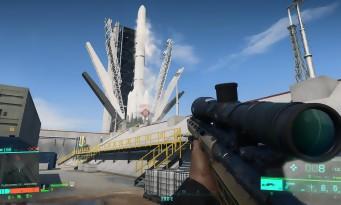 This new direction is immediately a major victim, since the traditional single-player campaign simply falls by the wayside. It is inevitably regrettable, and all the more astonishing that the introduction of the game still takes the trouble to set up a real universe. Following various climatic disasters, many refugees find themselves stateless and form the No-Pats group. Mercenaries ready to sell themselves to the highest bidder, they fight either for the United States or Russia. This is enough to justify the temporary commitment of players to this or that camp. The scripting does not go any further, even though it seems to have been put in place to justify the presence of specialists. These particular soldiers, who each have their own name and a well-defined face, more or less replace the old class system. From now on, any soldier can wield any weapon! Some veterans of the saga may not appreciate seeing their habits being shaken up in this way, but this change seems rather beneficial to us. More freedom, fewer limitations! And the presence of ten different specialists is there to ensure a certain heterogeneity and complementarity. Thus, for example, Sundance has a wingsuit and not a parachute, Dozer takes less explosive damage than the others but cannot use gadgets, Mackay moves quickly and can use a zip line, Paik has a scanner allowing him to spot enemies through obstacles, and Falk can heal allies from a distance with a syringe gun. This brief overview should convince you that each player will necessarily find the shoe that suits them. And if you ever want even more choice, remember that Battlefield 2042 is now a game-service. Four "Battle Passes" are planned for the coming year, each of them bringing its share of new maps and additional specialists. And if Electronic Arts keeps its promises, these additions will be free! A paid version of each pass will still be available for players who love cosmetic items.
This new direction is immediately a major victim, since the traditional single-player campaign simply falls by the wayside. It is inevitably regrettable, and all the more astonishing that the introduction of the game still takes the trouble to set up a real universe. Following various climatic disasters, many refugees find themselves stateless and form the No-Pats group. Mercenaries ready to sell themselves to the highest bidder, they fight either for the United States or Russia. This is enough to justify the temporary commitment of players to this or that camp. The scripting does not go any further, even though it seems to have been put in place to justify the presence of specialists. These particular soldiers, who each have their own name and a well-defined face, more or less replace the old class system. From now on, any soldier can wield any weapon! Some veterans of the saga may not appreciate seeing their habits being shaken up in this way, but this change seems rather beneficial to us. More freedom, fewer limitations! And the presence of ten different specialists is there to ensure a certain heterogeneity and complementarity. Thus, for example, Sundance has a wingsuit and not a parachute, Dozer takes less explosive damage than the others but cannot use gadgets, Mackay moves quickly and can use a zip line, Paik has a scanner allowing him to spot enemies through obstacles, and Falk can heal allies from a distance with a syringe gun. This brief overview should convince you that each player will necessarily find the shoe that suits them. And if you ever want even more choice, remember that Battlefield 2042 is now a game-service. Four "Battle Passes" are planned for the coming year, each of them bringing its share of new maps and additional specialists. And if Electronic Arts keeps its promises, these additions will be free! A paid version of each pass will still be available for players who love cosmetic items.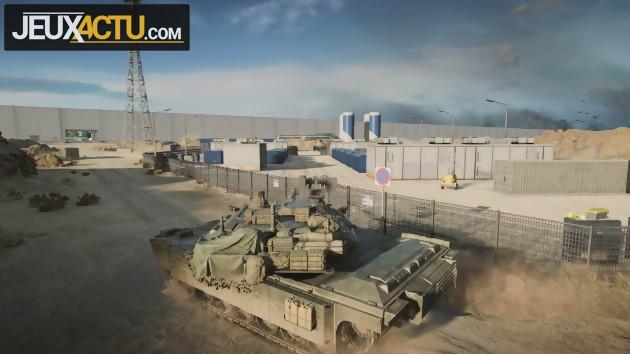
BREAK AND RENEWAL
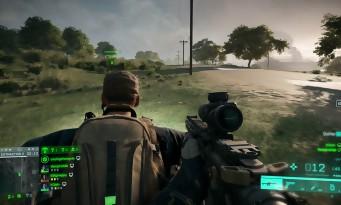 Who says new Battlefield, of course says new maps. They are here seven in number and each have their own atmosphere and particularities. Décharge places us in the middle of stranded ships on the west coast of India, Sablier immerses us in Doha and its sandstorms, Rupture is located in Antarctica and is home to destructible oil silos, the land of Kaleidoscope is surrounded by skyscrapers. South Korean skies, the Singaporean Manifesto is conducive to tropical tornadoes, Orbital takes us around Kourou minutes from a rocket liftoff, and Renouveau is an Egyptian map split in two, a giant wall separating a desert area from an area fertile. These maps are varied, they benefit from a good level design, and the different climatic events that disrupt the games are relatively impressive. But the most interesting comes from the new player limit, which has been increased from 64 to 128. The maps are therefore larger, which encourages the use of vehicles a little more, and above all the "battlefield" atmosphere is more sensitive than ever. The bullets fly everywhere, we rarely find ourselves alone, the explosions are incessant, there is always a tank or a helicopter to surprise us, and the storms sometimes come to upset all these beautiful people. Battlefield 2042 manages to marry multiplayer and great spectacle, which is not given to everyone. Note, however, that unlike "next-gen" platforms (including PC), the PS4 and Xbox One versions of the game remain limited to 64 players, with more compact cards so as not to create empty areas.
Who says new Battlefield, of course says new maps. They are here seven in number and each have their own atmosphere and particularities. Décharge places us in the middle of stranded ships on the west coast of India, Sablier immerses us in Doha and its sandstorms, Rupture is located in Antarctica and is home to destructible oil silos, the land of Kaleidoscope is surrounded by skyscrapers. South Korean skies, the Singaporean Manifesto is conducive to tropical tornadoes, Orbital takes us around Kourou minutes from a rocket liftoff, and Renouveau is an Egyptian map split in two, a giant wall separating a desert area from an area fertile. These maps are varied, they benefit from a good level design, and the different climatic events that disrupt the games are relatively impressive. But the most interesting comes from the new player limit, which has been increased from 64 to 128. The maps are therefore larger, which encourages the use of vehicles a little more, and above all the "battlefield" atmosphere is more sensitive than ever. The bullets fly everywhere, we rarely find ourselves alone, the explosions are incessant, there is always a tank or a helicopter to surprise us, and the storms sometimes come to upset all these beautiful people. Battlefield 2042 manages to marry multiplayer and great spectacle, which is not given to everyone. Note, however, that unlike "next-gen" platforms (including PC), the PS4 and Xbox One versions of the game remain limited to 64 players, with more compact cards so as not to create empty areas.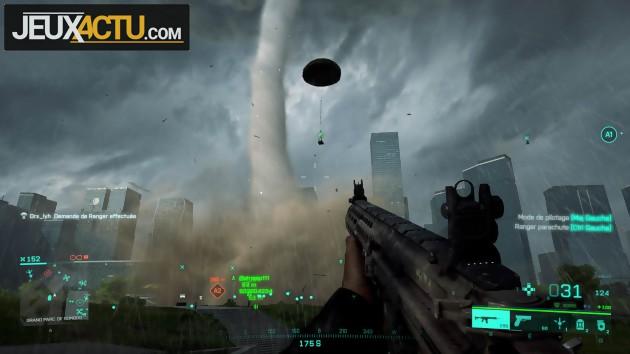
ALMOST COMPLETE MENU
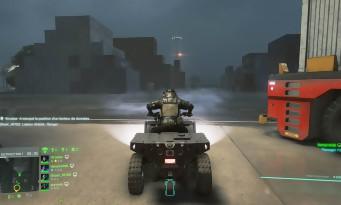 If DICE and Electronic Arts have skipped the single player campaign, they delight us on the other hand with regard to the multiplayer modes. Thus, the "All-out warfare" menu brings together the two most famous modes of the saga. Conquest involves capturing and holding various control points, while Breakthrough pits a team of attackers against a team of defenders. These crude descriptions don't necessarily do justice to the appeal of these two modes, but after almost twenty years of Battlefield, we're going to assume that you're already familiar with them. However, the sequel is completely new. The game offers us a brand new mode called Hazard Zone and oriented PvPvE. The 32 players in these games are divided into eight four-soldier squads, with each group battling both the AI and the other groups to repatriate data scattered across the map. More tactical than Conquest and Breakthrough, this mode requires good coordination on the part of the squad and is therefore particularly marvelous when playing with friends. It is also regrettable that the game does not offer voice chat, which requires the use of an external Discord-type solution. However, the developers have announced that they are working on this feature, which should therefore arrive within a few weeks.
If DICE and Electronic Arts have skipped the single player campaign, they delight us on the other hand with regard to the multiplayer modes. Thus, the "All-out warfare" menu brings together the two most famous modes of the saga. Conquest involves capturing and holding various control points, while Breakthrough pits a team of attackers against a team of defenders. These crude descriptions don't necessarily do justice to the appeal of these two modes, but after almost twenty years of Battlefield, we're going to assume that you're already familiar with them. However, the sequel is completely new. The game offers us a brand new mode called Hazard Zone and oriented PvPvE. The 32 players in these games are divided into eight four-soldier squads, with each group battling both the AI and the other groups to repatriate data scattered across the map. More tactical than Conquest and Breakthrough, this mode requires good coordination on the part of the squad and is therefore particularly marvelous when playing with friends. It is also regrettable that the game does not offer voice chat, which requires the use of an external Discord-type solution. However, the developers have announced that they are working on this feature, which should therefore arrive within a few weeks.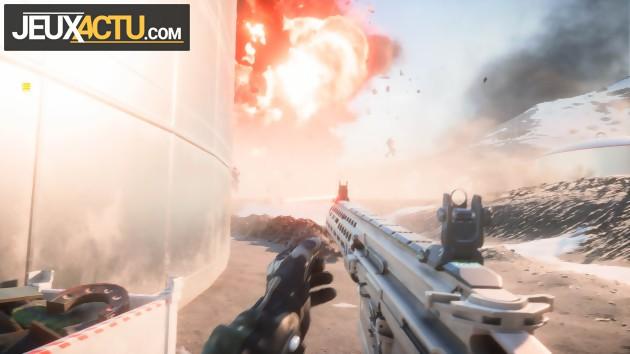
In the meantime, you will always have the opportunity to take advantage of the other great novelty of this episode, entitled Battlefield Portal. This is a tool for concocting totally personalized games, or simply joining them if you don't have the creative soul. It is possible to choose from five modes (Breakthrough, Conquest, Large Conquest, Team Deathmatch, Free-for-all), thirteen maps (the seven maps of 2042 plus six other maps from Battlefield 1942, Battlefield Bad Company 2 and Battlefield 3), and tons of settings. Number of players, types of soldiers or vehicles allowed, damage or bullet speed multipliers, health regeneration, interface elements or AI behavior are just a few examples of the available settings. A rule editor is even available for some modes. Almost all delusions are allowed. The other side of the coin is that many players use this tool and the freedom it allows to create servers to farm experience artificially. The impossibility of creating a game directly from the game (it is necessary to go through a website) is also regrettable. But the chances of getting exciting new modes through this tool are very high. Especially since the arrival of additional settings is also planned in the future, always within the framework of the game-service.


























